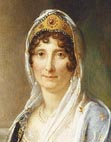| |
| |
PRESIDENT'S MESSAGE
For the first bulletin of 2006, I would like to thank you for your continuing interest in napoleon.org: indeed there were more than 2.6 millions sessions in 2005, a figure in line with the steady increase in interest which we have recorded since the site's inception in 1996! This year is therefore the site's tenth birthday, ten years of enthusiasm shared with you for the history of the two Napoleons.
I wish you a very happy 2006.
Victor-André Masséna, prince d'Essling

|
|
|
| |
AUCTION: PORTRAIT OF MADAME MERE, BY GERARD
Sotheby's is to hold an important sale on 26 January in New York which includes an exceptional portrait of Madame Mère by Gérard. Commissioned by the First Consul, this painting exists in three different versions, and it is the first version (which emphasises Letizia Bonaparte's specific virtues as mother of a family as opposed to the later versions which concentrate on Letizia's status as mother of the emperor) that is up for auction. Detail © Sotheby's

|
|
|
| |
THIS MONTH'S BOOK
Waterloo: Napoleon's Last Gamble, by Andrew Roberts
Exceptionally, for Book of the Month, we bring you here the 'dark side', in other words, not the best but rather the worst. After an ill-judged article on Napoleon by the author in the Daily Mail in December, this review of a new book by him appears to confirm our worst fears that Andrew Roberts is losing his critical faculties... © HarperCollins

|
|
|
| |
150 YEARS AGO
On 5 January, 1856, Ferdinand de Lesseps finally completed the statutes for the Compagnie universelle du canal de Suez. The concession to dig and exploit the canal had been granted by Said Pacha to Ferdinand de Lesseps on 30 November, 1854. The digging began in 1859, and the canal was inaugurated in November 1869.
Why not (re-)visit our trilingual Suez Canal Special Dossier recounting the building of the Suez Canal.
9 January, 1856, saw the birth of Louis Conneau, son of Napoleon III's personal doctor and friend, Henri Conneau (1803-1877).
Great friends, the future emperor and his doctor had known each other since 1820, when Henri Conneau was personal secretary in Italy to Louis, Louis-Napoléon's father. In 1831, Louis-Napoléon and Conneau participated actively in diverse revolutionary activities between Rome and Forli. They then returned with Queen Hortense to Arenenberg, where Henri Conneau, who had qualified as a doctor in Italy, looked after Hortense until her death in 1837. As a devoted friend, Conneau took part in the wretched Boulogne coup d'état attempt (1840) and was imprisoned for five years with Louis-Napoléon, who himself had been locked up for life, in the Fort de Ham. During these five years, Conneau remained devoted to Louis and helped him escape from the prison in 1846. Louis never forgot this, and on becoming president (1848) and then emperor (1852), the latter heaped honours upon his friend (Légion d'honneur, etc.) and appointed him as personal physician to the emperor. Member of the Académie de médecien, Conneau also became Député for the Somme constituency and then senator. He served as special envoy preparing the secret Plombières meeting between Napoléon III and Cavour. This friendship was even to survive the catastrophic campaign of 1870, and it was together they went into captivity both at Wilhelmshöhe and then later to Chislehurst until Napoleon III's death in 1873. Conneau only lived four years after this.
It was therefore only natural that in (1856) Louis Conneau should become the future Prince Impérial's inseparable companion when the latter was born a few weeks later. When serving later in the French army, Louis Conneau was to distinguish himself as a general in the First World War. Remaining faithful to his friendship with the Prince Impérial, Conneau was to remain in contact with the Empress Eugénie until her death in 1920.
200 YEARS AGO
On 7 January, 1806, Napoleon replied to the Pope Pius VII's letter of 23 November, 1805, in which the pontiff had been concerned regarding French intentions concerning the Holy See after the French occupation of the port and fort of Ancona. For Napoleon, as King of Italy, this was merely preventative measures safeguarding the coasts and borders of the Papal States from the risk of landings by Russian or British troops (as occurred in Naples in 1805, as part of the allied plans for a southern diversion during the Austerlitz campaign). He therefore tried to reassure Pius:
« Most Holy Father […] I could not but be deeply affected when all the powers in English pay formed a coalition to bring upon me an unjust war. […]
The occupation of Ancona was the immediate and necessary result of the poor organisation of the Holy See's military affairs. It was better for your holiness that this fortress be in my hands than in those of the English or the Turks. […] I saw myself, just as my predecessors of the second and third dynasties did, as the eldest son of the church, as the only one with a sword able to protect her and to prevent her from being besmirched by Greeks and Muslims. I shall provide constant protection for the Holy See, despite the duplicity, the ingratitude and poor behaviour of the men who have revealed their true faces in these last three months.
[…] If your Holiness wishes to expel my minister, he is at liberty to do so; he is free to prefer to accommodate the English and the Caliph of Constantinople; but since I do not wish to expose Cardinal Fesch to such indignities, I shall have him replaced by a non religious. »
Correspondence, letter n° 9655
Wishing you an excellent, Napoleonic, week.
Peter Hicks
Historian and Web editor
THE NAPOLEON.ORG BULLETIN, No 354, 6 - 12 January, 2006
Interested in the work of the Fondation Napoléon? Why not participate, either generally or in a specific project, by making a donation.
© this Napoleon.org weekly bulletin is published by the Fondation Napoléon. Reproduction or all or part of this bulletin is forbidden, without prior agreement of the Fondation Napoléon.

|
|
|
|
|
|
|
|
|
|
|
|
COMMEMORATIONS
The presence at the one, and absence of the other, of French state representatives at the commemorations in 2005 (Trafalgar and Austerlitz respectively) have given rise to questions being asked in the French parliament. The Député for the Côtes d'Armor constituency, Marc Le Fur, has sent a written question to the defence minister enquiring as to the deciding factors in the choice of presence or not of state representatives at commemorative ceremonies.
This question (n° 80299) was published in the Journal officiel of 6 December, 2005 (p. 11173).
Click here for the question.
THIS WEEK
WHAT'S ON
- Exhibition: Napoleon in Caricature, Bratislava, Slovakia
- Exhibition: Napoleon: Art and Empire in the age of Trafalgar, Barnard Castle, UK - Closing soon
- Exhibition: "Battle in a sittingroom." The Austerlitz wallpaper, Rome, Italy
- Exhibition: In the Service of Napoleon. The Dutch in time of War 1792-1815, Delft, Netherlands
- Exhibition: Napoleon on Campaign, the emperor's bivouac, at the Arc de triomphe de l'Etoile, Paris, France
- Exhibition: Napoleon: An intimate portrait, Washington, USA
Got a problem with the letter? Try the home page: http://www.napoleon.org
<<
|
|



